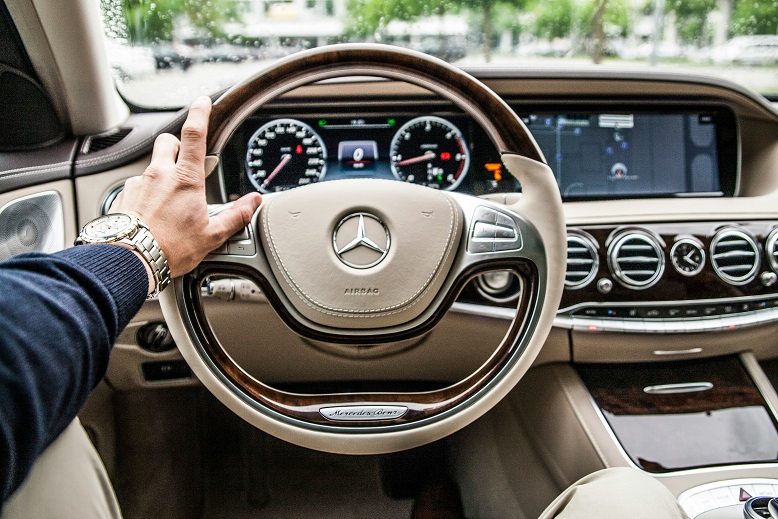Driving in Spain is a great way to experience stunning landscapes, scenic coastal roads, and well-maintained highways, but before you get behind the wheel, make sure you are familiar with the key differences in driving laws, road etiquette, and documentation requirements.
 Driving on the Right Side of the Road
Driving on the Right Side of the Road
We’re pretty sure if you are reading this article, you already knew this, but worth stating, just in case! The most obvious difference for a British driver is that Spaniards drive on the right-hand side of the road, with left-hand drive vehicles. It might sound simple, but things to remember are that roundabouts are navigated counterclockwise, and overtaking is done on the left. It may take a little getting used to, especially when exiting car parks or joining roads, so you have to be super conscious as you turn any corners and make sure that your autopilot doesn’t take over.
Speed Limits and Road Signs
Speed limits in Spain differ depending on the type of road:
- Motorways (Autopistas – AP) and Dual Carriageways (Autovías – A): 120 km/h (75 mph)
- Conventional Roads: 90 km/h (56 mph)
- Urban Areas: 50 km/h (31 mph), though many residential zones have reduced limits of 30 km/h (19 mph)
Speed cameras are common, and fines can be issued automatically. Unlike in the UK, Spanish authorities can enforce on-the-spot fines for speeding, which must often be paid immediately.
Essential Documents for Driving in Spain
When hiring a car, you must carry the following:
- Full UK driving licence (paper licences are not valid; ensure you have a photocard licence)
- Passport or official ID
- Vehicle rental agreement
- Proof of insurance (provided by the rental company, but check coverage details)
- International Driving Permit (IDP) if your UK licence was issued in Gibraltar, Guernsey, Jersey, or the Isle of Man
Hiring a Car in Spain
Car rental companies typically require drivers to be at least 21 years old (sometimes 25 for higher-end models) and to have held a licence for a minimum period (often one year). A credit card is usually required for the deposit. Be sure to inspect the vehicle thoroughly for any damage before leaving the rental site and ensure you understand the fuel policy.
Do your research before you go in order to get the best car hire deal. You should also be aware that many car hire websites will give you a seemingly really good price for car hire, but when you arrive to pick up the car they try to sell you fully comprehensive insurance, which isn’t always included. It is worth checking out Insurance for Car Hire as this can often work out much cheaper, especially if you are planning on going more than once a year.
Road Etiquette and Local Driving Customs
Spanish drivers tend to be more assertive than British drivers, particularly in cities. Some key points to remember:
- Roundabouts: Drivers already on the roundabout usually have right of way, but this isn’t always respected.
- Horn Use: It is illegal to use a car horn unnecessarily in urban areas, except in emergencies.
- Flashing Lights: If a driver flashes their lights at you, it often means “I’m coming through” rather than a courteous “After you” as in the UK.
- Pedestrian Crossings: Vehicles are required to stop for pedestrians at marked crossings, and failure to do so can result in heavy fines.
Parking Regulations
Parking rules vary by region, but here are some general guidelines:
- Blue Zones: Paid parking areas requiring a ticket from a nearby machine.
- Yellow Lines: No parking.
- White Lines: Free parking areas.
- Underground Car Parks: A good option in busy cities, though they can be expensive.
- Illegally parked cars may be towed away, and retrieving them can be costly and time-consuming.
Tolls and Payment Methods
Spain has an extensive toll road network (Autopistas, marked AP). Payment can be made in cash or by credit card, though some toll booths now use electronic systems such as Via-T for automatic payments. Alternative non-toll routes (Autovías, marked A) are available, though they may be slower and busier.
Drink-Driving Limits
Spain has stricter drink-driving laws than the UK:
- General Limit: 0.5 g/l in blood (around one small glass of wine or beer)
- For New Drivers (<2 years experience): 0.3 g/l
Random breath tests are common, and exceeding the limit can result in heavy fines, loss of licence, or even imprisonment.
Motorway Breakdowns and Emergency Procedures
In case of a breakdown:
- Move the car to a safe spot, away from traffic.
- Wear a reflective vest (legally required when exiting a vehicle on a highway).
- Place a warning triangle (two are required if driving a non-Spanish registered vehicle).
- Call roadside assistance or emergency services (112 for general emergencies, 062 for the Guardia Civil traffic division).
Driving in Cities vs. Rural Areas
Driving in major Spanish cities like Madrid and Barcelona can be challenging due to heavy traffic, narrow streets, and strict parking restrictions. Many cities have low-emission zones, where only authorised vehicles can enter. Always check local regulations before driving into a city centre.
On the other hand, rural roads, especially in mountainous areas, can be winding and poorly lit at night. Watch out for cyclists and farm vehicles.
Final Tips for a Smooth Journey
- Always have spare cash or a credit card for tolls.
- Avoid driving in major cities if possible—public transport is often more convenient.
- Be mindful of local driving habits and road signs.
- Familiarise yourself with basic Spanish road terms (e.g., “Salida” for exit, “Ceda el paso” for give way).
Related articles
Travelling around Spain by train
Spain has an excellent train network that is both affordable and efficient, making it a fantastic way to explore the
Guide to using the metros in Spain
There are five Metro systems in Spain, one in each of the following cities: Madrid, Barcelona, Valencia, Bilbao and Palma
Getting around Spain by bus
Spain boasts an extensive and efficient bus network that offers tourists an affordable and flexible way to explore the country.
